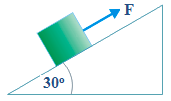1. Object’s mass = 2 kg, acceleration due to gravity = 9.8 m/s2, coefficient of the static friction = 0.2, coefficient of the kinetic friction = 0.1. Is the object at rest or accelerating? If the object is accelerated, find (a) the net force (b) magnitude and direction of the box’s acceleration!

Solution

Known :
Mass (m) = 2 kg
Acceleration due to gravity (g) = 9.8 m/s2
Coefficient of the static friction (μs) = 0.2
Coefficient of the kinetic friction (μk) = 0.1
Weight (w) = m g = (2)(9.8) = 19.6 Newton
The horizontal component of the weight (wx) = w sin 30o = (19.6)(0.5) = 9.8 Newton
The vertical component of th weight (wy) = w cos 30o = (19.6)(0.5√3) = 9.8√3 Newton
The normal force (N) = wy = 9.8√3 Newton
Force of the static friction (fs) = (0.2)(9.8√3) = 1.96√3 Newton = 3.39 Newton
Force of the kinetic friction (fk) = (0.1)(9.8√3) = 0.98√3 Newton = 1.69 Newton
Solution :
Object is at rest if wx < fs, object is moving down if wx > fs.
wx = 9.8 Newton and fs = 3.39 Newton.
(a) the net force
∑F = wx – fk = 9.8 – 1.69 = 8.11 Newton
(b) magnitude and direction of the acceleration
∑F = m a
8.11 = (2) a
a = 4.05
Magnitude of the acceleration = 4.05 m/s2 and direction of the acceleration = downward.
2. Object’s mass = 4 kg, acceleration due to gravity = 9,8 m/s2. Coefficient of the kinetic friction = 0.2 and coefficient of the static friction = 0.4. Magnitude of the force F = 40 Newton. The object is at rest or slides down ? If the object slides down, find (a) the net force (b) magnitude and direction of the acceleration!

Solution

Known :
Mass (m) = 4 kg
Acceleration due to gravity (g) = 9.8 m/s2
The coefficient of the static friction (μs) = 0.4
The coefficient of the kinetic friction (μk) = 0.2
Weight (w) = m g = (4)(9.8) = 39.2 Newton
The horizontal component of the weight (wx) = w sin 30o = (39.2)(0.5) = 19.6 Newton
The vertical component of the weight (wy) = w cos 30o = (392)(0..5√3) = 19.6√3 Newton
The normal force (N) = wy = 19.6√3 Newton = 33.95 Newton
the static friction force (fs) = μs N = (0,4)(33.95) = 13.58 Newton
The kinetic friction force (fk) = μk N = (0.2)(33.95) = 6.79 Newton
F = 40 Newton
Solution :
The object slides down if F < wx + fs. The object slides up if F > wx + fs.
F = 40 Newton, wx = 19.6 Newton and fs = 13.58 Newton.
F is greater than wx + fs so the object slides up.
(a) The net force
∑F = F – wx – fk = 40 – 19.6 – 6.79 = 13.61 Newton
(b) The magnitude and direction of the acceleration
∑F = m a
6.4 = (4) a
a = 1.6
The magnitude of the acceleration is 1.6 m/s2 and direction of the acceleration is upward.
[wpdm_package id=’481′]
- Mass and weight
- Normal force
- Newton’s second law of motion
- Friction force
- Motion on the horizontal surface without friction force
- The motion of two bodies with the same acceleration on the rough horizontal surface with the friction force
- Motion on the inclined plane without friction force
- Motion on the rough inclined plane with the friction force
- Motion in an elevator
- The motion of bodies connected by cord and pulley
- Two bodies with the same magnitude of accelerations
- Rounding a flat curve – dynamics of circular motion
- Rounding a banked curve – dynamics of circular motion
- Uniform motion in a horizontal circle
- Centripetal force in uniform circular motion
